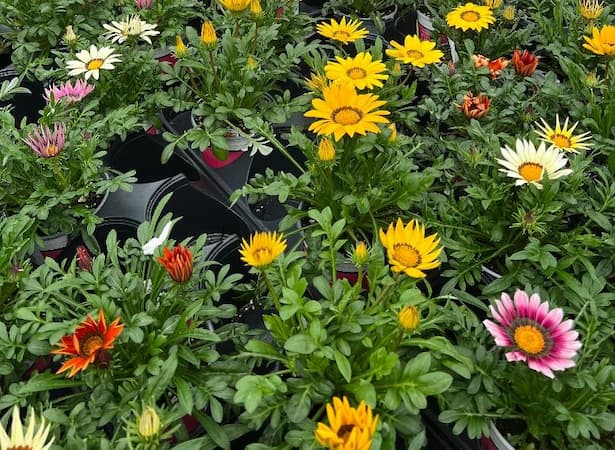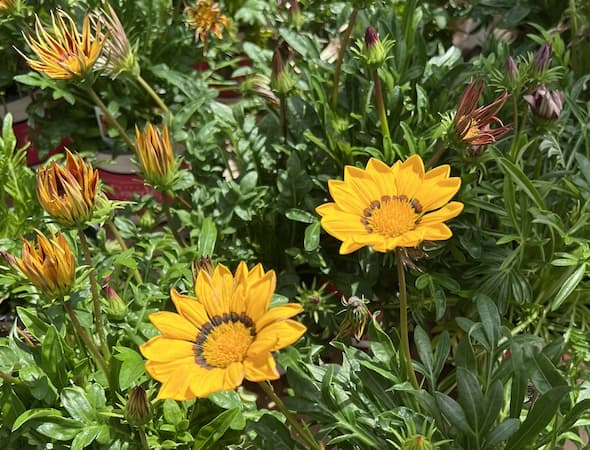How to Grow Gazania Flowers

About Growing Gazania Plants in Your Home Flower Garden
Summer droughts in your area? No problem! Try growing Gazania flowers. Native to South Africa, Gazania plants are perennials that are grown as an annual in more northerly areas of the country. The plants thrive in hot weather and dry soils. Low-maintenance Gazania plants are named after the 15th-century Greek-Italian scholar Theodorus of Gaza. Gazania is an exciting perennial. Medium green, leathery leaves give way to vibrant, exotic-looking flowers. When in bloom, they will be strikingly attractive wherever you locate them. The flowers attract bees and other pollinators.
Outdoors, try growing Gazania in flower beds, rock gardens, and containers on your patio or deck. They brighten up any area with a burst of vibrant colors where they are grown. Gazania plants are popular as houseplants, too. However, the plants need at least full sunlight to bloom. So, grow them indoors by a sunny window.
Plant Specifications
Bright flower colors include red, orange, yellow, pink, white, and variations of these colors. The flowers close up for the evening, about 3:00 p.m.
Flowers Bloom: Summer through Fall
Plant Height: 10 – 12 inches tall.
Light Requirements: Full sun.
Ideal Soil pH: 6.0 – 8.0.
Hardiness Zone: 9 – 11.
Toxicity: They are non-toxic to humans and animals.
Native To: South Africa
Plant Type: Perennial
Botanical Name: Dianthus
Are Gazania Plants Edible?
YES, but don’t eat them.
If you consume gazania plants tit won’t kill you. However, they don’t taste good. And, more importantly, it can cause you temporary discomfort.
We recommend you simply enjoy the beauty of these flowers and leave them out of the kitchen.

Gazania Flower Medicinal Uses
Like many other flowers, Gazania plants have medicinal applications, several of them. The plants have antioxidant, anti-inflammatory, and antimicrobial properties.
They include:
- Use it to treat toothaches.
- Promotes healing of cuts, scrapes, and minor wounds.
- Prevent miscarriage.
- Ease sore eyes.
- It is used as a treatment for pneumonia.
- Alleviate headaches and earaches.
Perennial Gazania Plant Propagation
Gazania plants are grown from seeds. Sow Gazania seeds directly into your flower garden after all risk of frost has passed. You can also start Gazania indoors, 6 – 8 weeks before the last frost. Don’t transplant them into your garden until all risk of frost has passed.
Sow seeds 1/8″ deep, and cover lightly with fine garden soil, or seed starting soil.
While Gazanias are usually grown as an annual, they can be grown as a perennial in warmer areas of the country. After a few years, the plants may become crowded. Dig up and divide into clumps to re-plant. Give a few clumps to a thankful gardening friend, too.
Gazania plants can also be propagated by rooting cuttings.
Final Plant Spacing: 9″ – 12″
Ideal Germination Temperature: 60-65 degrees
Days to Germination: 10 – 15 days.
Light Requirements
These plants thrive in the heat and sunlight of their native South Africa. So, plant them where they will receive full sunlight. They need at least 6 to 8 hours of direct sunlight to bloom. Also, insufficient sunlight results in lanky plants. If grown in flowerpots on your deck, you can move the plants around to give them plenty of sunlight.
How to Grow Perennial Gazania Flower Plants
Gazania plants are easy to grow. They do well in hot, dry weather. They even tolerate salt!! Grow plants in full sun.
Gazania prefers good to average, sandy soil. The soil needs to be well-drained.
Established plants do best in dry soil conditions. Water plants only during long, extended droughts. Allow the soil to completely dry between watering. Then, water deeply.
Gazania plants do not need a lot of fertilizer to perform well. But, like many other plants, they respond well when you mix compost into the planting site before sowing seeds or transplanting young plants. If you plant them in really poor soil, fertilize them every 4 – 6 weeks with a general-purpose fertilizer.
Bring indoors in the fall, before the first frost, and grow Gazania as a houseplant. Also, check the plant and soil carefully for bugs, before bringing the plant indoors.
Pruning Gazania Flower Plants
Remove any dead or sick-looking leaves and stems. Thinning the plant a little helps to increase air circulation and a healthier plant. But, don’t thin them too much.
Deadhead spent flowers to promote new blooms. It helps to prolong the blooming period.
Insects and Plant Disease
Insect and disease problems are not common. Aphids and spider mite infestations can occur.
Powdery mildew can be a problem in wet and humid conditions.
As soon as you spot an insect or disease problem, treat the plants with insecticide, repellents, or fungicides, as needed.
Overwintering Gazania Plants
Gardeners and homeowners growing gazania plants in warm regions that do not experience frost or freeze can enjoy growing these beautiful plants year-round.
Many middle states in the U.S. can overwinter them by cutting the plants back to near the ground. Cover the area with mulch to protect the roots from freezing. Then in the spring rake the mulch off of the area.
For cold, northerly regions, dig up the roots and plant them into flowerpots. Then, grow them indoors. Place them in a sunny window.
Related Articles
Also, people who read this article on Gazania flowers will like:
Plant Problems – Identify the causes and find the cures.
Please support our site. Shop for:
- rmmatthews100@hotmail.com
- 585-721-6528
- Rochester, NY
©1999-2024 GardenersNet.Com, All Rights Reserved

